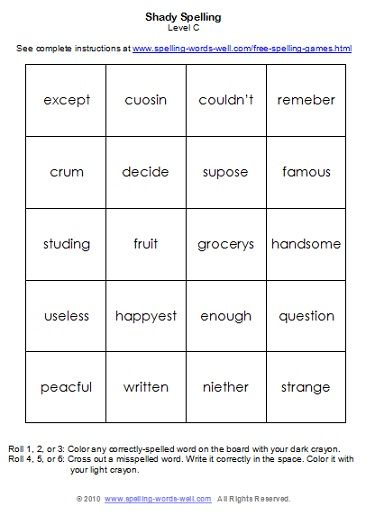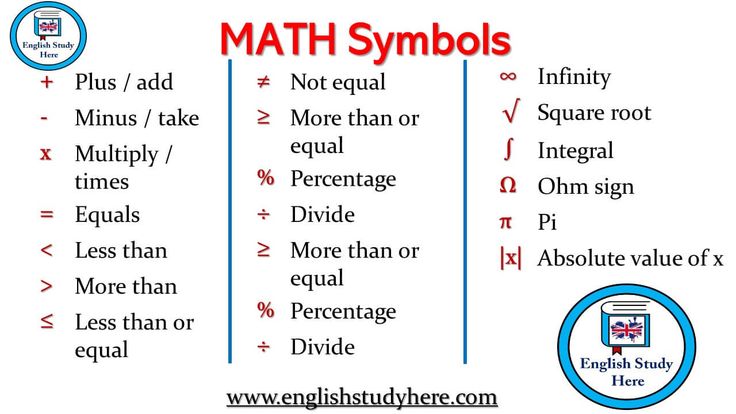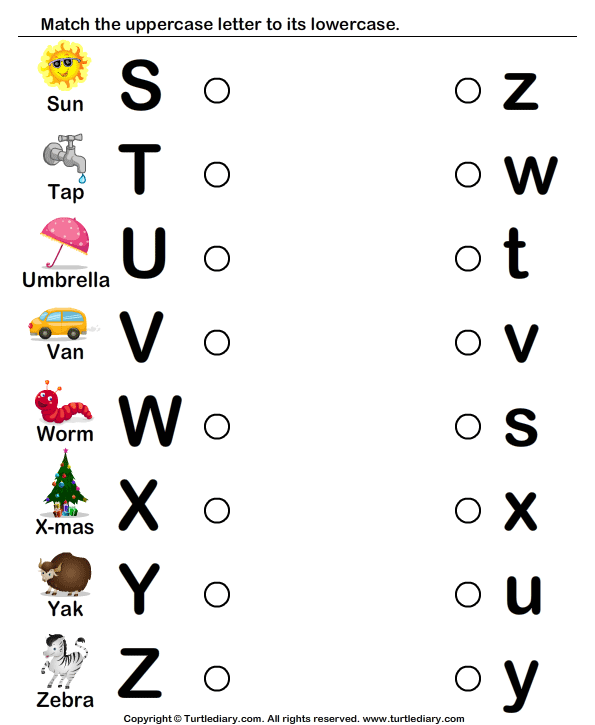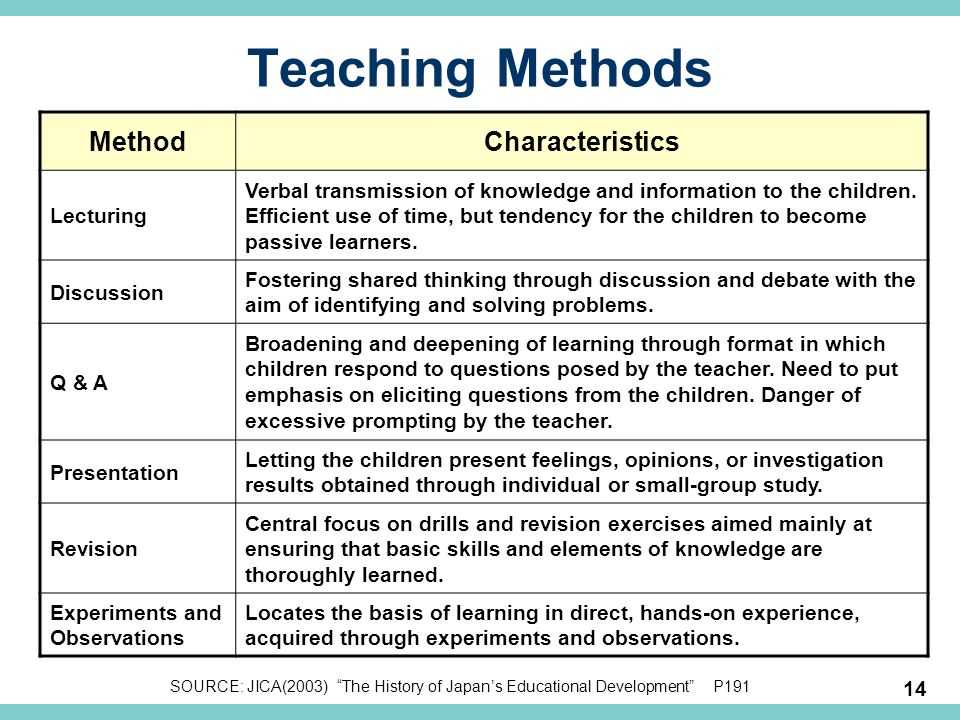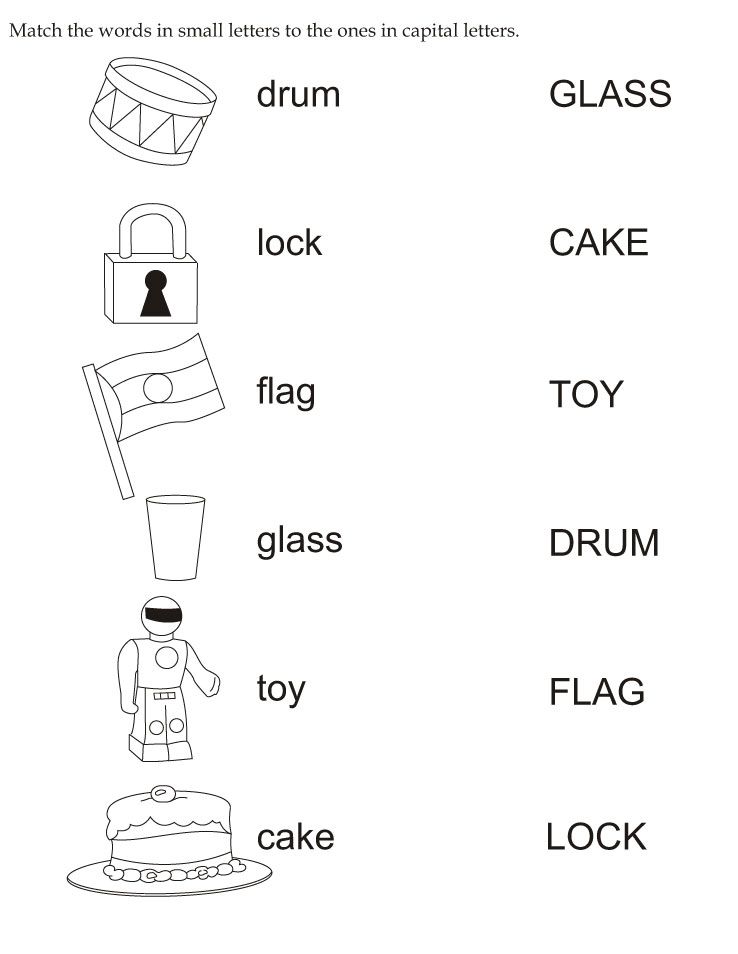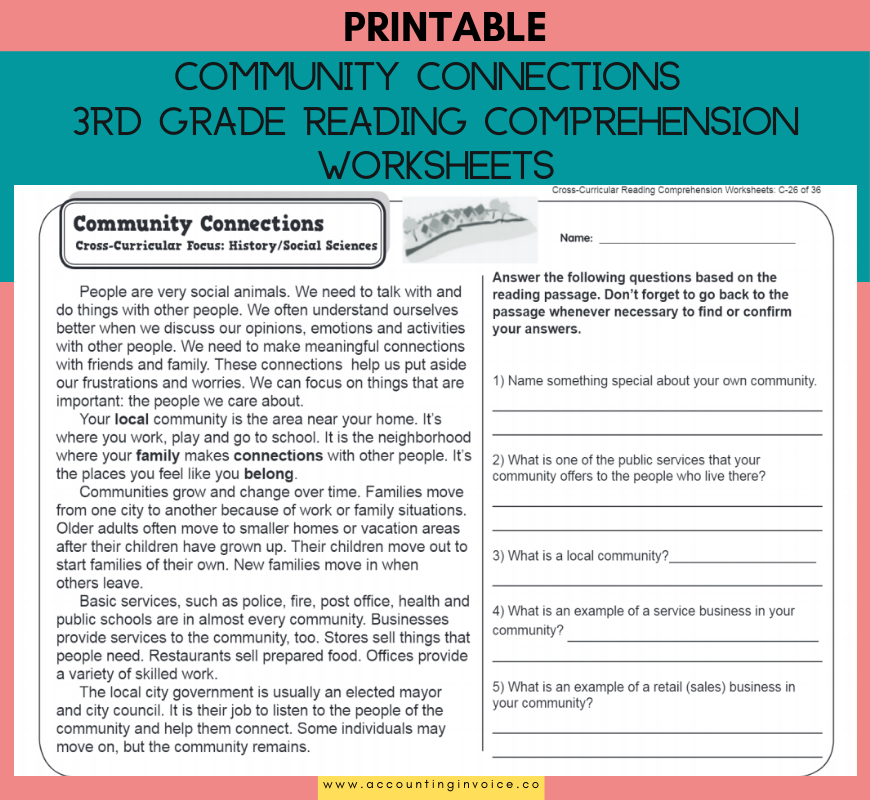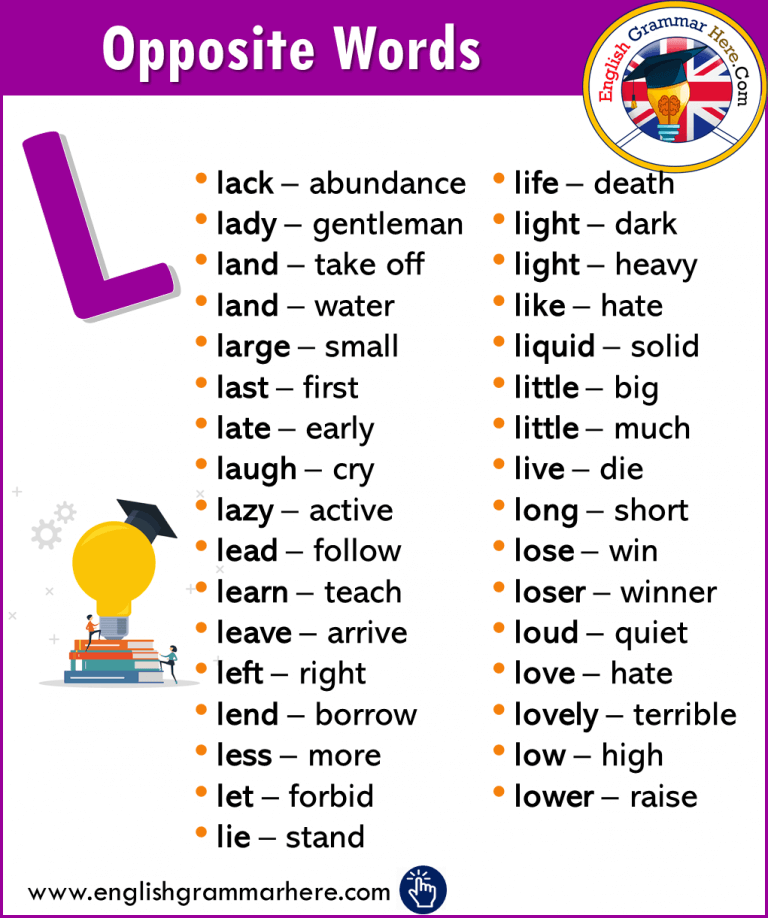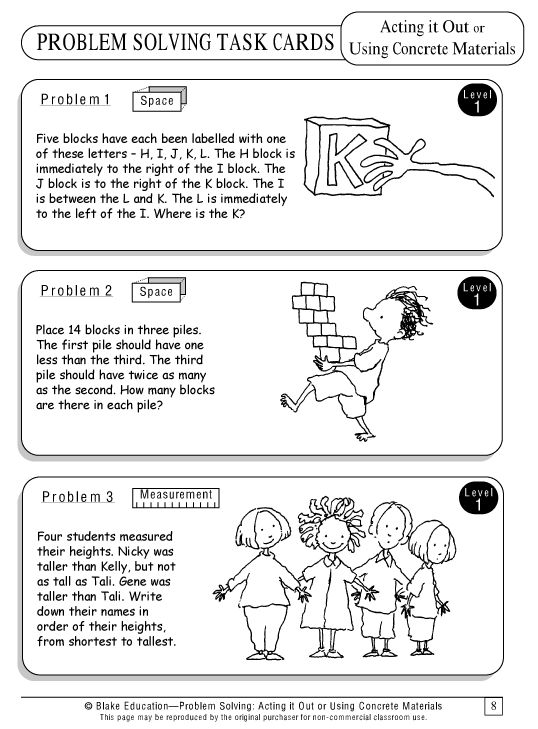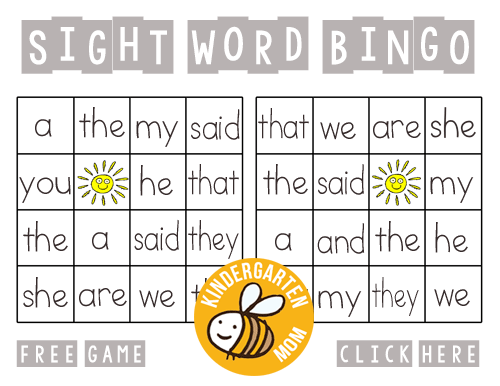Help child reading comprehension
My Child Struggles With Reading Comprehension. What Can I Do?
Knowing how to read and understanding what you read are two very different things. Many children are able to pronounce every word in a passage, but they lack reading comprehension skills, which means they don’t understand what the passage means.
Strong reading comprehension skills are crucial to your child’s academic and professional success. That’s why if you’ve ever thought, “My child struggles with reading comprehension,” it’s important to know what you can do to help your child improve these vital skills.
What Are the Signs Of A Reading Comprehension Problem?
It can be hard to spot the signs of a reading comprehension problem. This is especially true if your child has strong decoding and fluency skills, which means they are able to correctly pronounce words and read quickly.
Knowing how to spot the signs of a reading comprehension problem is the key to getting your child the help they need to succeed. Here are some of the signs you should look for:
- Your child is unable to determine the difference between important and minor details of a passage.
- Your child struggles to connect two different ideas within a passage.
- Your child cannot summarize what they have read or answer questions about the characters, main events, or other elements of the story.
- Your child can read a lot of words, but doesn’t understand what they mean.
If you spot any of these signs, it could indicate that your child is struggling with reading comprehension.
Why Does My Child Have Trouble With Reading Comprehension?
There are a number of reasons why a child may struggle to develop strong reading comprehension skills. Some of the most common causes of reading comprehension problems include:
- Dyslexia: This learning disability makes reading much more difficult, which can impact a child’s ability to understand what they are reading.
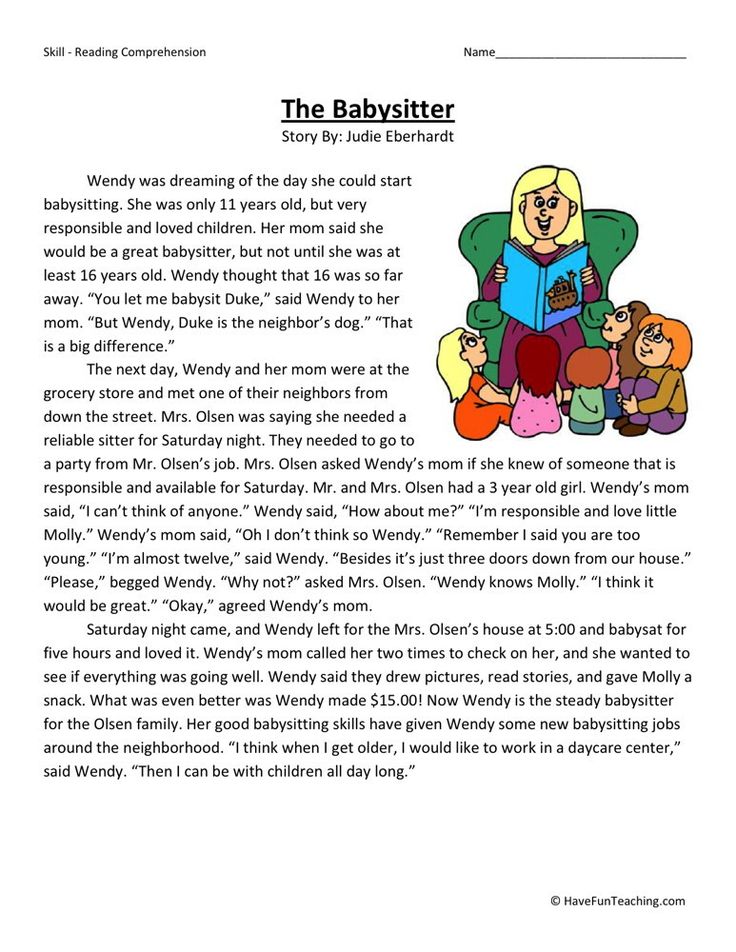
- Attention deficit hyperactivity disorder (ADHD): Kids with ADHD find it hard to pay attention, so they may not be able to focus on what they are reading, which can impact their ability to understand it.
- Lack of interest: If your child is not interested in reading, they may not be motivated to focus on the text.
- Limited vocabulary: If your child’s vocabulary is limited, they may find it difficult to extract meaning from a text since they won’t be familiar with most of the words.
- Lack of instruction: Some children struggle with reading comprehension simply because they have not been taught how to develop these skills.
As a parent, you should try to pinpoint the underlying issue that is causing your child’s reading comprehension problem. This will help you determine the best strategy that can be implemented to improve your child’s reading comprehension skills.
How Can I Improve My Child’s Reading Comprehension?
There are countless ways that parents can help improve their child’s reading comprehension skills at home. Try these strategies:
Try these strategies:
Ask Questions
Parents should get in the habit of asking their child questions about the text they are reading. Don’t wait until your child has finished reading a story to ask. You should try to ask them questions before, during, and after they finish reading. Start with these:
- What do you think this story will be about based on the cover’s illustrations?
- What do you think will happen next?
- What caused this event to happen?
- What was the character feeling when he said or did this?
- What’s the main character’s name?
Asking questions like these will keep your child engaged in the story, help them connect ideas, and deepen their understanding of the text.
Choose the Right Books
Let your child choose what they want to read. Letting your child choose will give them the opportunity to select a book that they are actually interested in
reading. This may improve their ability to focus, which will enhance their reading comprehension skills.
You should also make sure that you are choosing level-appropriate books. If the text is too difficult for your child, it will be incredibly challenging for them to understand what they are reading.
Reread Difficult Passages
If your child doesn’t understand a passage, ask them to reread it with you. Then, use this as an opportunity to teach them how to extract meaning from a difficult passage.
If they encounter a word they aren’t familiar with, show them how to look it up in the dictionary. Point to context clues in the passage that they can use to figure out what the text means. Help them connect the events of the story to something that has happened in their life.
Teaching your child these strategies will help them drastically improve their reading comprehension skills.
What is the Best Reading Comprehension App For Struggling Readers?
One tool that parents can use to help their children improve their reading comprehension skills is the Readability app.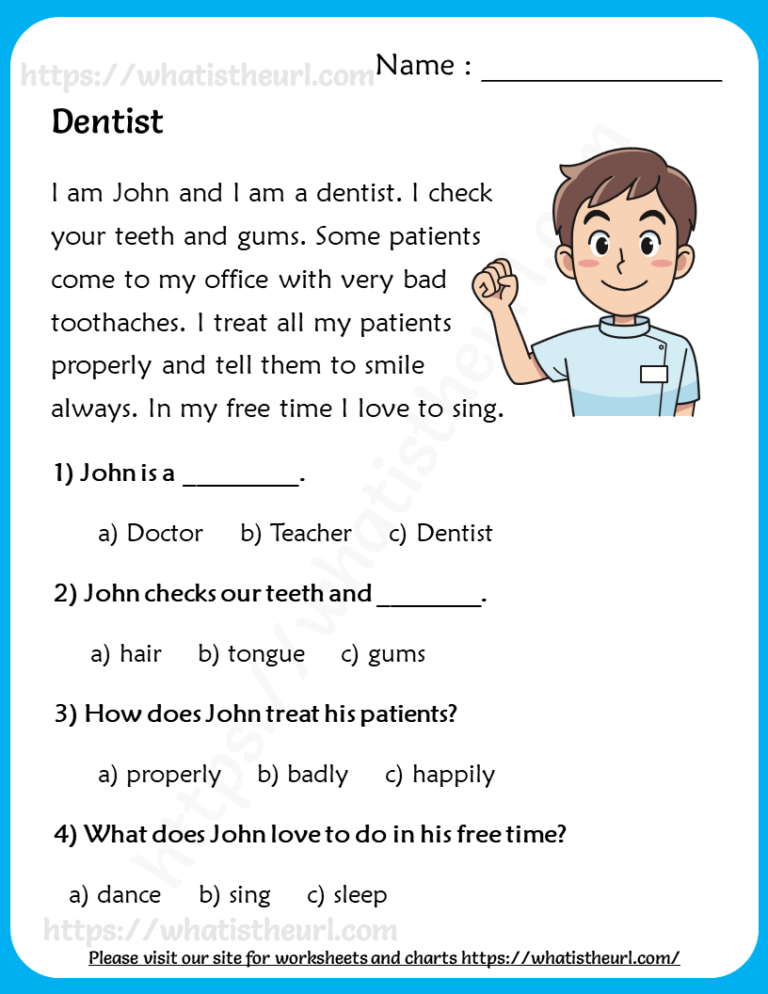 Readability is the only app that is designed with a voice-based questions & answers feature, which allows your child to communicate with the app like they would with a
reading tutor.
Readability is the only app that is designed with a voice-based questions & answers feature, which allows your child to communicate with the app like they would with a
reading tutor.
The app will ask your child questions about the text and listen as your child responds to confirm that they understood the passage. This innovative feature will keep your child engaged with what they are reading, which can help them develop stronger reading comprehension skills.
Download the Readability app on your smartphone or tablet to start the free 7-day trial today.
100 Ways to Help you Child Improve Their Reading Comprehension Skills
Reading comprehension involves a child’s ability to understand the context and meaning of text. Young readers quickly learn to summarize or retell story plots and identify the main characters—basic elements of comprehension. Inferencing, the ability to make predictions on what will happen based on clues within the text, is a fundamental aspect of comprehension that is integral to reading proficiency.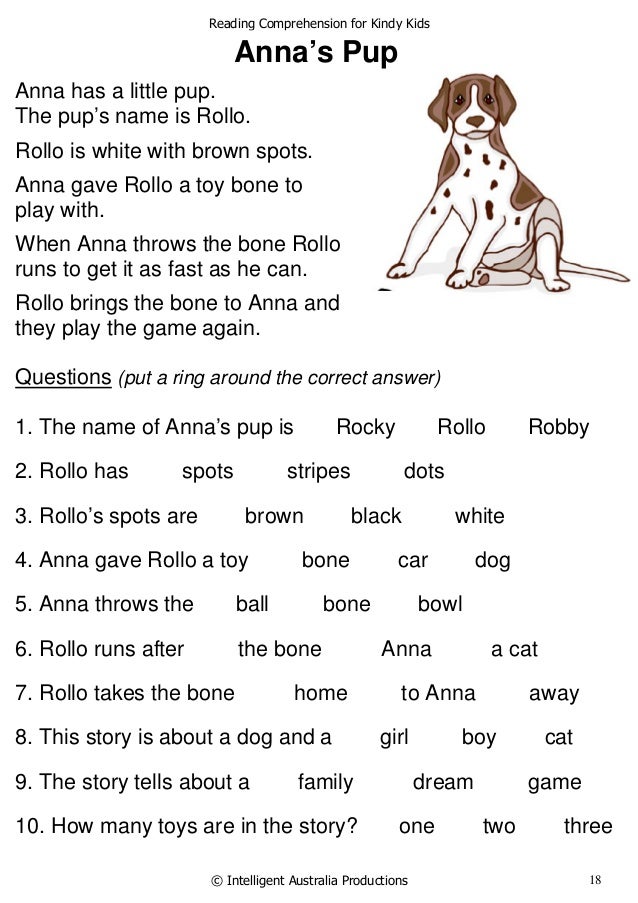
As text becomes more abstract, readers must find the unwritten meanings that help them develop a greater understanding of the story. Unsure how to help a struggling reader? Here are 100 ways to help your child improve reading comprehension, love the adventure of reading and enjoy exploring new books! Some of these tips may be an adventure for parents, too!
- Ask questions when you read. The key comprehension questions are who, what, when, where, why and how. Your child should be able to answer these basic questions about the story or book.
- Cook a recipe. Cooking and following a recipe could help with basic comprehension skills. Measuring also helps your child with math!
- Narrate the story. Don’t just read aloud, narrate the story for your child. Inflect emotion and excitement to help them understand elements of the plot and motivations of the characters.
- Listen to the book. Listening to a book while following along in the text could help a child to better grasp plot elements or infer meaning.
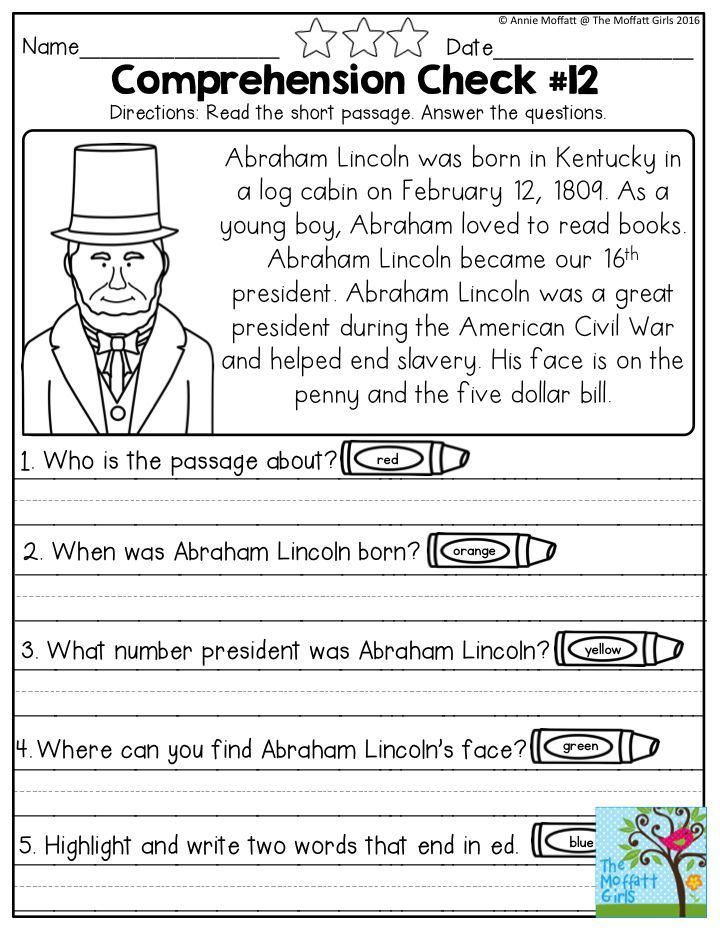
- Start a family reading club. Everyone in the family should read the same book. After everyone finishes the story, talk about the plot and characters in depth together.
- Use reading worksheets. Online worksheets are available on numerous websites to help parents work on reading comprehension with their child. Some worksheets include questions to gauge understanding.
- Make a reading comprehension bookmark. A bookmark can serve as a visual reminder to help children think about plot elements and help identify those key “wh” questions.
- Use graphic organizers. A graphic organizer can help focus on plot, characters or other aspects of the story. This is yet another visual way to help with comprehension.
- Watch the movie together. After reading the book, watch the movie. Then discuss how the book differs from the big screen adaptation.
- Play reading games. Download games or apps that focus on reading skills.
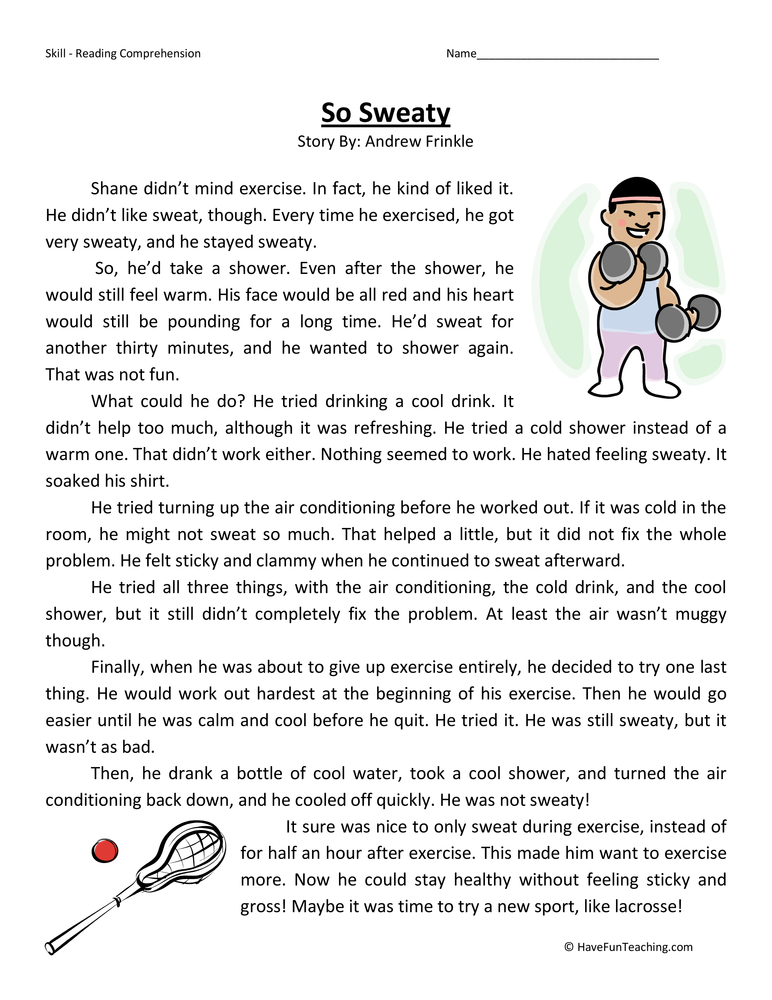 Or create your own games at home.
Or create your own games at home. - Use a reading app. Readability provides struggling readers with an AI virtual tutor that helps guide reading lessons and tests comprehension. The tutor recognizes your child’s voice and provides guidance on pronunciation. After the story is completed, the tutor will ask questions related to the story.
- Let children choose their books. Kids may be more excited about reading when they get to choose their own books.
- Take a reading field trip. Visit a site featured in your child’s favorite book. Maybe it’s a museum, the zoo or somewhere else. This is yet another way for a child to immerse into the action of the story.
- Make a story comprehension ball. Grab a beach ball and write comprehension prompts on each of the colorful sections. Toss the ball to your child and have them answer the prompt that faces up when they catch the ball. You can also buy a ball!
- Write a storybook.
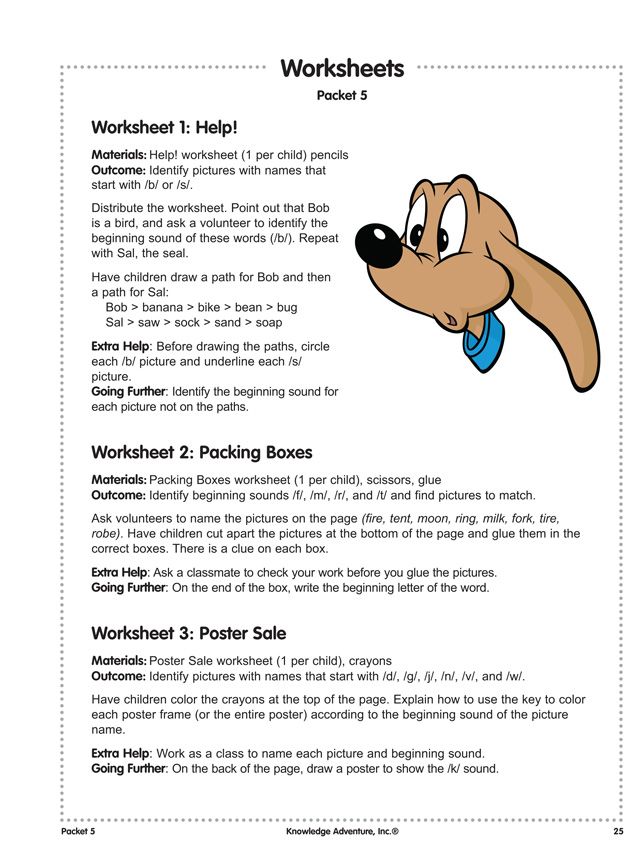 Have your child write their own fiction story. By creating a plot and characters, they also have to think beyond the basics.
Have your child write their own fiction story. By creating a plot and characters, they also have to think beyond the basics. - Draw pictures. Have your child illustrate a scene from the story. This may help them visualize the action of the story.
- Create a shoebox diorama. This is a small three-dimensional recreation of a scene from the story. Like an illustration, this could help a child visualize and better understand a scene.
- Meet with the teacher. When parents are concerned about comprehension, one of the first steps to address the issue may be a meeting with a child’s teacher. Don’t hesitate to reach out.
- Hire a private tutor. If money isn’t an issue, a private tutor could work one-on-one with a child to help focus on comprehension struggles.
- Read, read, read. Encourage children to read regularly to help work on proficiency and comprehension.
- Start a book club during the summer.
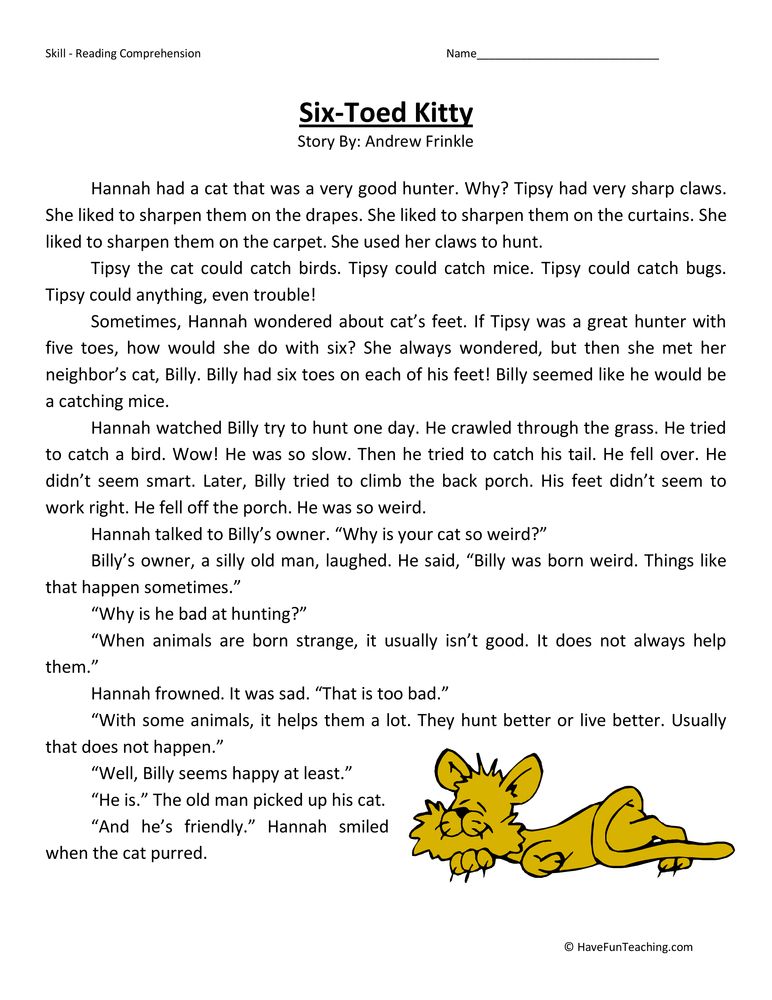 If the local library doesn’t offer a summer reading program, start your own. Encourage children to track reading minutes and offer prizes for milestones and program completion. This encourages regular reading during the summer and could help them to not fall behind…in comprehension and proficiency.
If the local library doesn’t offer a summer reading program, start your own. Encourage children to track reading minutes and offer prizes for milestones and program completion. This encourages regular reading during the summer and could help them to not fall behind…in comprehension and proficiency. - Offer reading rewards. For kids who dislike reading, a rewards program may be beneficial to get them to crack a book and work on comprehension. Set rewards that will motivate your child.
- Set reading goals related to comprehension. Reading rewards should be tied to reading goals. These goals could be related to comprehension, page numbers or reading minutes.
- Understand your child’s reading level. Parents should always know what reading level is best for their child, so that books are never too easy or too difficult. Ask your child’s teacher to better understand individual reading levels.
- Choose books that are leveled appropriately.
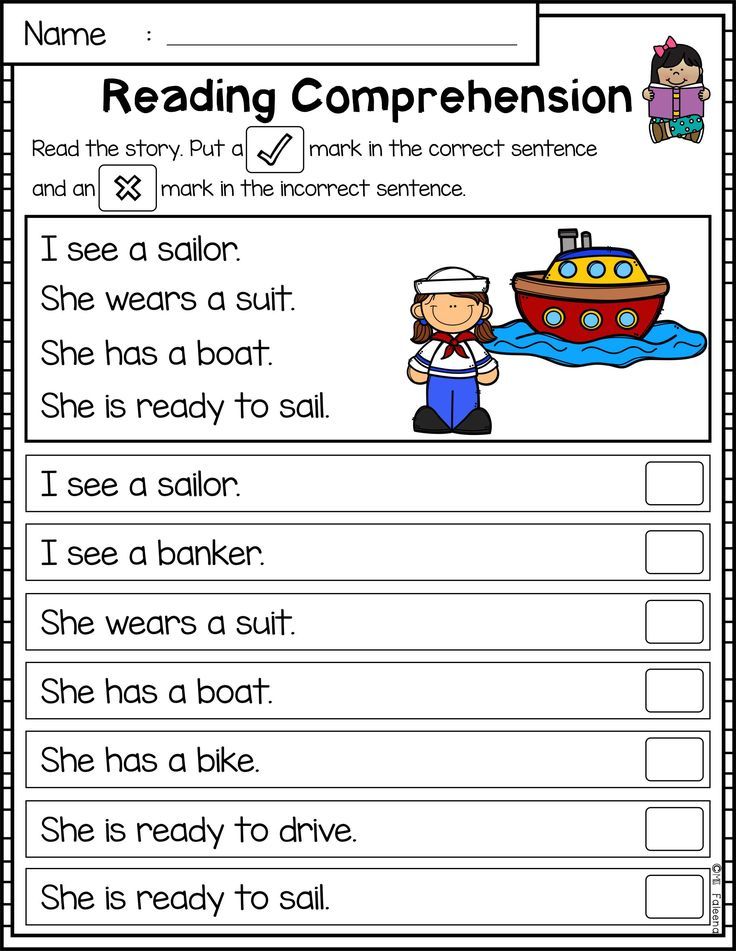 Don’t select books that are too far outside a child’s reading level. Working on comprehension requires text that a child can easily understand.
Don’t select books that are too far outside a child’s reading level. Working on comprehension requires text that a child can easily understand. - Read aloud to a child. Hearing a book read aloud could help a child understand the plot or the character’s actions. This also can be a child’s gateway to more difficult books.
- Create a reading den. Make reading fun by creating a reading nook or den. Grab pillows, covers or your child’s favorite stuffed animals.
- Stop the clock. Understand that the clock doesn’t always rule reading. Sometimes it’s ok to not watch the clock.
- Make a book craft. After reading the book, have your child make a craft related to the story. Your child can create a puppet based on the character of a book.
- Let children read to a furry friend. Our pets don’t judge mistakes. Let your child read aloud to the family pet. This is a great way to help them practice reading fluency.
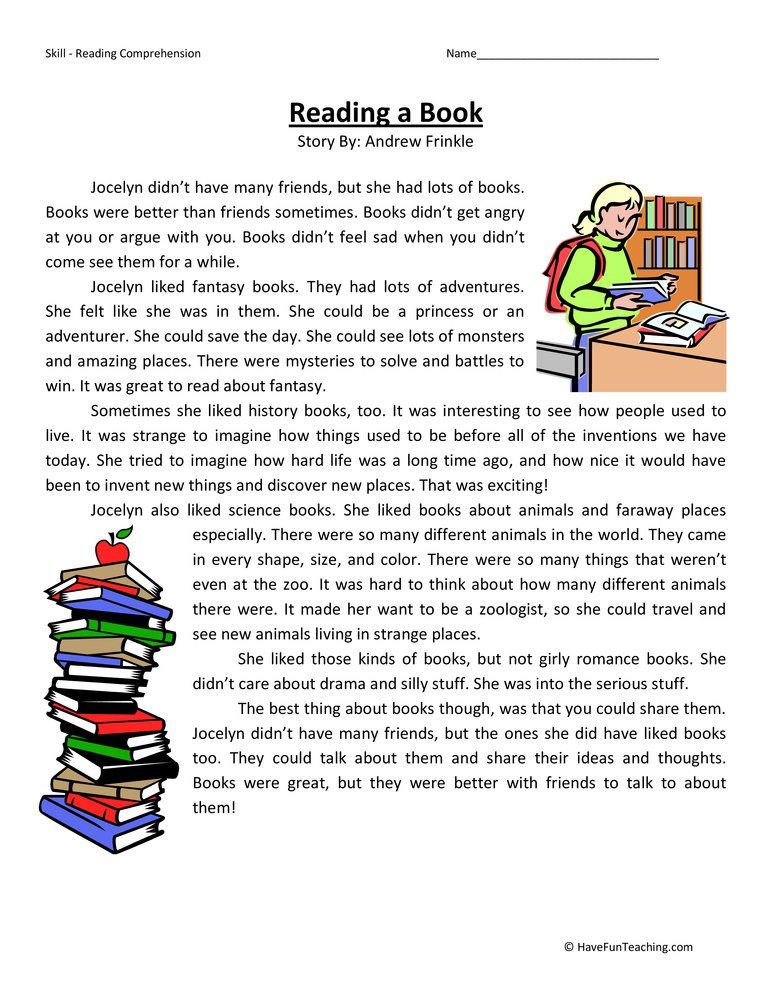
- Make a book interest list. Not sure what books interest your child? Have them make a list of favorite sports, hobbies, ideas and more. Then find books related to the interest list.
- Review reading scores from school-based standardized tests. If you’re unsure if your child is reading at grade level, ask to review standardized test scores. These are usually sent home, but sometimes schools forget. Just ask your child’s teacher to review.
- Talk to a pediatrician if reading struggles are pronounced. If your child is really struggling to sound out words and comprehend text, schedule an appointment with your child’s pediatrician to seek guidance.
- Ask for referrals. If your child’s doctor is concerned, they may recommend that your child see a specialist; ask for referrals so you know whom to consult. You may also need to check your insurance plan to find in-network specialists.
- Ask the school for intervention or further testing.
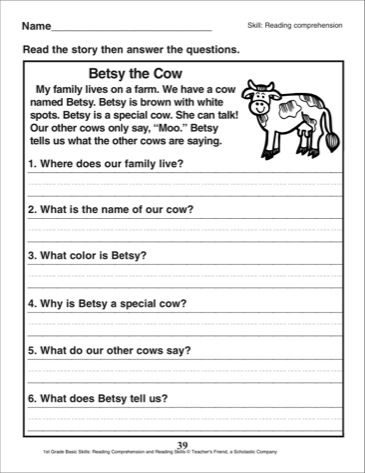 Reach out to the school to inquire about testing for reading struggles.
Reach out to the school to inquire about testing for reading struggles. - Never shame a struggling reader.
- But praise progress and effort. Always offer praise for progress and effort. Positive words may go a long way to a child that is struggling.
- Investigate different types of reading programs. Not every app or program works for every child. Do your research.
- Find out what reading environment works best for your child. Do they like to read alone? On the couch? Talk to your child about where they love to read, and try to make accommodations.
- Encourage reading breaks. Don’t push a child to read to the brink of exhaustion. Even when your child is completely lost in a book, encourage them to rest their eyes and take a reading break.
- Don’t make reading a chore. All parents can nag, but try not to make reading assignments into a dreaded task. This is sometimes how those reading minutes can backfire (depending on the child).
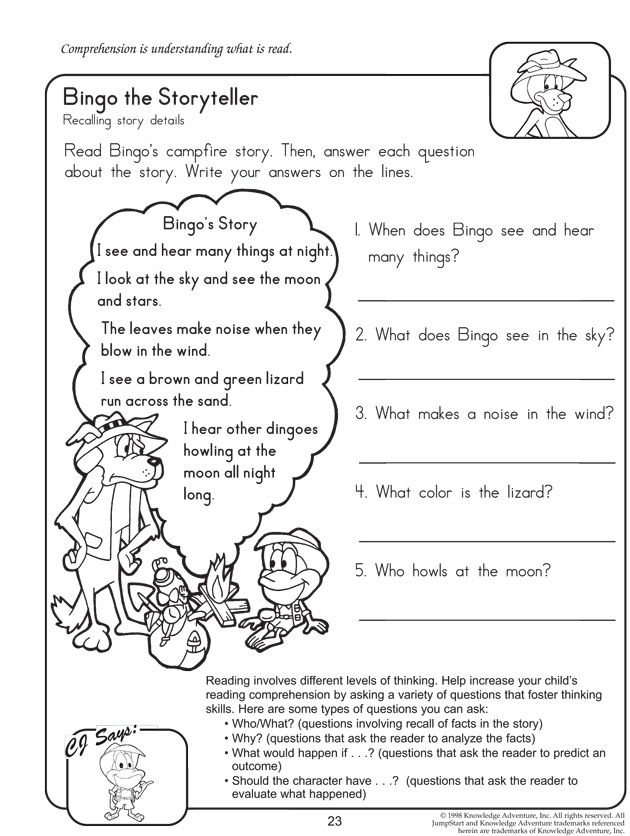 Some kids see reading minutes as “I need to get through this.” They never enjoy the story or the book because they resent being forced to do reading for those mandated 20 minutes. Encourage fun reading, and let kids read at their pace.
Some kids see reading minutes as “I need to get through this.” They never enjoy the story or the book because they resent being forced to do reading for those mandated 20 minutes. Encourage fun reading, and let kids read at their pace. - Set reasonable expectations. Don’t make reading goals unattainable.
- Understand that all reading is practice. Comic books count!
- Don’t compare a struggling reader to a peer or sibling.
- Talk to a child. Ask them to summarize their day. Ask them what happened in school. Ask them anything. Getting them to articulate their own experiences may help them articulate what they read, too. You might even focus on “wh” questions
- Read books to celebrate or commemorate history. For Fourth of July, read about the Revolutionary War and our Constitution. During Black History Month, encourage children to read about historical figures in the Civil Rights movement.
- Incorporate comprehension into daily activities.
 Talk about your day, an activity you’re doing and the steps you take to complete the activity. Incorporate those ‘wh’ questions.
Talk about your day, an activity you’re doing and the steps you take to complete the activity. Incorporate those ‘wh’ questions. - Use comprehension strategies across subjects. Focusing on comprehension is vital for the understanding of all subjects. Make sure your child understands history and science by asking comprehension questions related to assignments and reading.
- Enjoy a reading snack related to the book.
- Set the clock for fun reading races. If your child needs to work on proficiency, set a timer and encourage them to read a paragraph without making any mistakes.
- Parents need to read, too. Kids should see parents reading and enjoying a book. Kids learn by example.
- Encourage kids to write book reports. When kids finish the book, have them write up an old-fashioned book report detailing what they liked about the story and talking about the characters.
- Inquire about school resources in the classroom.
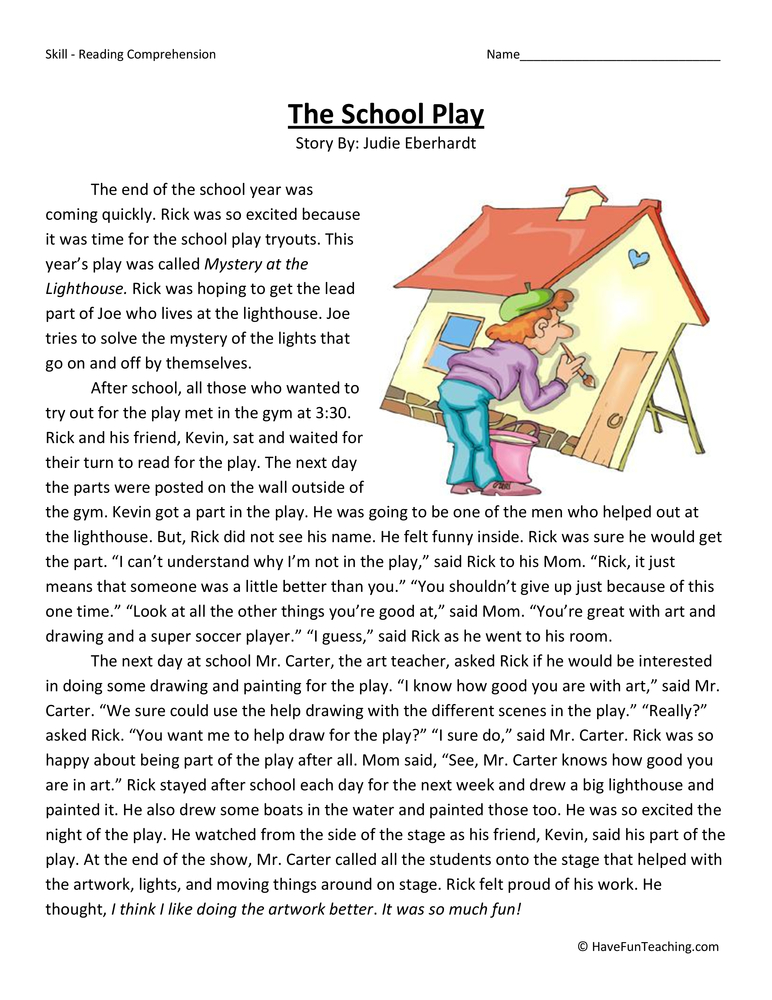 Do you know what type of reading resources your child’s school offers? Ask! You may be able to use programs or resources at home.
Do you know what type of reading resources your child’s school offers? Ask! You may be able to use programs or resources at home. - Mirror the teacher’s strategies. Inquire about what reading strategies your child’s teacher uses in the classroom. Use these same strategies at home.
- Encourage children to chunk the text to help ease comprehension struggles. Have children chunk text by reading a paragraph at a time…or a chapter. Then ask them questions about what they’ve read.
- Reenact a fun scene from the book. Is this a dinner party? An amazing adventure. Reenact it with kids and home to help them immerse in the story.
- Make sure kids know they aren’t alone in their struggles. Explain to them that many students struggle with reading. In fact, about 10 million struggle with reading.
- Don’t let children avoid reading. While understanding a story may be a challenge, don’t let kids avoid reading.
 Sit with them, help them and encourage them…but don’t let them give up.
Sit with them, help them and encourage them…but don’t let them give up. - Have kids write a brief autobiography. Encourage them to retell an adventure; write down these adventures and use your child’s personal story to help them with aspects of comprehension. How did they feel? What did they learn? Make sure the adventure was a real one!
- Use books as rewards for reading. The best reward for reading? More books!
- Take your child to get a library card. Make a big event out of going to the library for their very first card…explain that this is their ticket to read any book they want!
- Check your library’s web site for special events related to reading clubs or other activities that could increase your child’s enjoyment of books and reading.
- Ask the librarian for book recommendations to help with comprehension. Librarians are great resources.
- Have your child create a hero list of famous people and find books about them for your child.

- Make sure any reading program you consider to help with comprehension has a free trial. Don’t risk paying for an app that doesn’t meet the needs of your child.
- Don’t stop reading during school breaks. The summer slide happens when children fail to keep reading or don’t engage in any meaningful educational activities (even doing math workbooks helps!).
- Check in with your child during reading to make sure they aren’t struggling.
- Visit thrift stores to find inexpensive books. Some may offer kids’ books for a mere quarter! Check out thrift stores near you!
- Utilize free ‘little libraries’ around the community when money’s too tight. Remember, take a book, give a book. Or, at the very least, remember to return the book you took from this free resource.
- Find books related to your child’s favorite shows.
- Explore free reading resources on PBSKids.
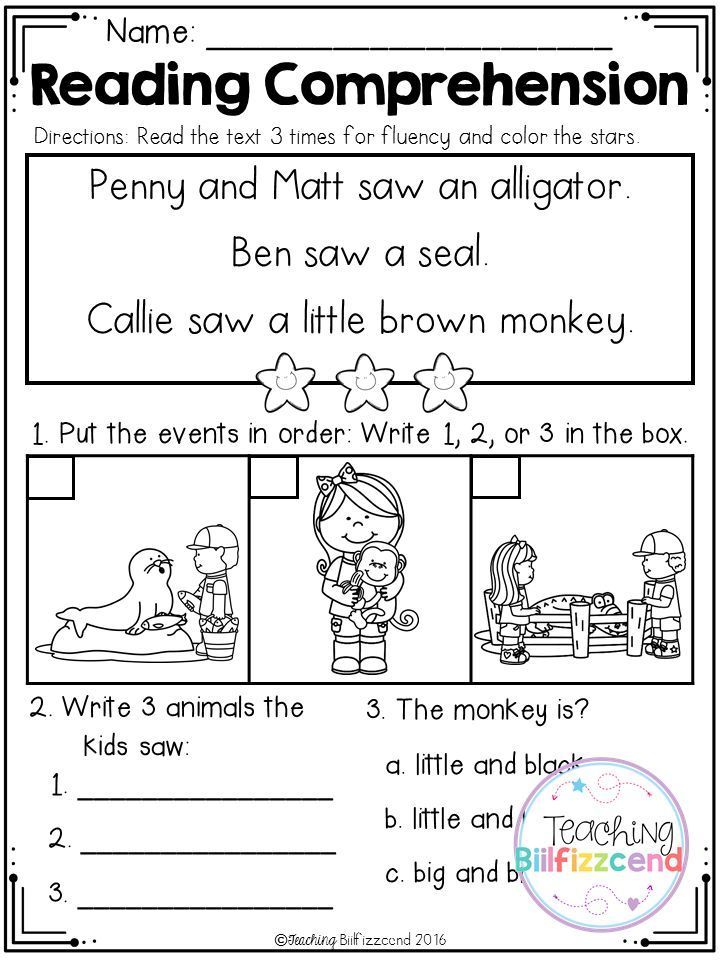 org.
org. - Play comprehension hopscotch. Write comprehension prompts on the squares!
- Embrace virtual books for children who love technology. Download ebooks to your favorite ereader!
- Give your child some reading holidays. On break, give them a brief reading reprieve for a few days.
- Celebrate National Poetry Month in April by reading poetry or introducing your child to your favorite poets.
- On April 12, make sure your child celebrates D.E.A.R. (Drop Everything and Read Day!)
- For children who have difficulty with comprehension because of dyslexia or another learning disability, the month of October is Learning Disabilities and Dyslexia Awareness Month. You can find resources about learning disabilities or choose to be an advocate to educate others this month.
- During the month of October, parents can make reading fun by adopting a Halloween theme for at-home reading activities.
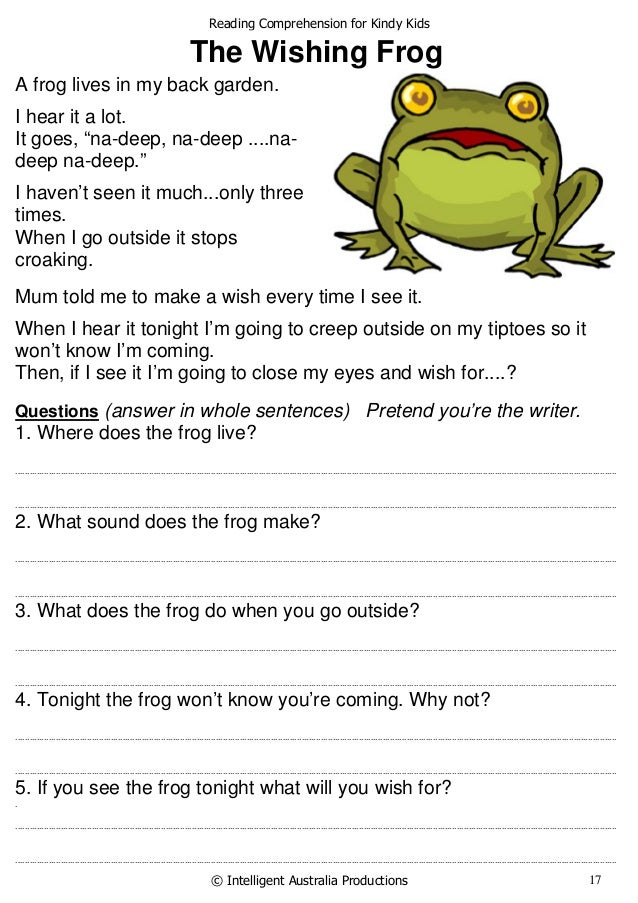 Candy rewards, scary stories and even fun Halloween snacks can all be included.
Candy rewards, scary stories and even fun Halloween snacks can all be included. - In November, help your child choose books on thankfulness, the first Thanksgiving or Native Americans. Remember, encourage your child to pick the books they want.
- December is the month of many holidays. Read about Christmas, Hanukah, or Kwanzaa. Talk to kids about these holidays to gauge their holiday comprehension. You may even read about holiday traditions across the globe. In Dutch traditions, St. Nicholas would leave candy or toys in children’s shoes!
- For February, embrace stories of love or Valentine’s Day history to work on comprehension. Fairy tales with happily-ever-after endings are a perfect choice for this month.
- Let your child read a comic strip (geared for kids) and talk about it together! Comic strips are a quick read, and may be an easy way to go over basic comprehension.
- Create comprehension quizzes for children to test their knowledge of the book.

- Understand that nightly reading minutes don’t always mean 20 minutes each night. If kids read for an hour, this counts toward the 100 weekly minutes. Don’t overthink reading minutes and turn reading into a chore.
- Does your child enjoy building models? Reading and following the instructions may help them with comprehension. Talk about each step and ask questions related to the process as they build.
- Remove distractions. When a child is reading, make sure that any noisy distractions are removed. Turn off the radio and the television!
- Encourage your child to read aloud. Note their inflection during the story and see if they can pick up on emotions of characters.
- To analyze characters, have children create a chart comparing and contrasting main characters in a story. How are they alike? How are they different?
- Ask kids to make predictions. Reading aloud to kids? After each chapter, ask your child what they think might happen next.
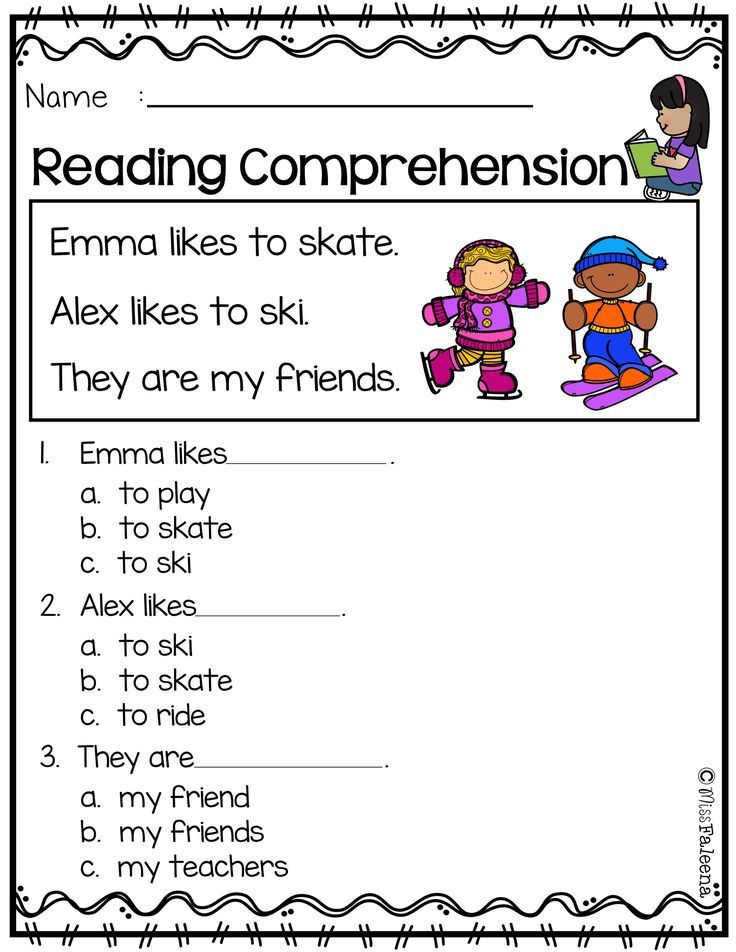
- Check out different reading landmarks in your area. These can be places featured in books, independent bookstores, or libraries.
- Take the reading outdoors. Read out in nature to change the scenery! Encourage beach reading during vacation…just don’t forget the sunscreen!
- Talk to your child if you find that they are getting discouraged. Make sure to always provide positive reinforcement during reading.
- Know when you need a parent break. Parents can get frustrated if we feel a child isn’t listening or doing what they need to do. Sometimes, though, their struggle is just overwhelming them. If you feel that you’re losing your cool, step back. Take a parent break.
- Step into character by role playing parts of the book. You can use puppets, too.
- If your child is hungry, overly tired or sick, reading could be more of a struggle. If a child can’t focus because they are tired, need to eat or just feel bad, they might not pick up much from what they read.
 Use common sense before pushing those nightly reading sessions.
Use common sense before pushing those nightly reading sessions. - Understand that an illness or a bad night with little sleep also could affect a child’s scores on a reading test. If scores were below expectations—and not the norm for your child—don’t assume reading has become a major problem. Reach out to your child’s teacher, and inquire if the child should be retested. If your child’s teacher is concerned, they will let you know.
- Host a family reading night each week. Everyone can hang out in the living room with their favorite book. This is a great way to unplug…and unwind. It also creates a reading habit for kids.
- Don’t book shame a child. If they love a silly book, let them read it.
- Find poems that were turned into songs! Listen to the song and talk about meaning. How does the music set the tone for the story/poem?
- Don’t ban books without researching. As kids get older, parents may want to police their reading material.
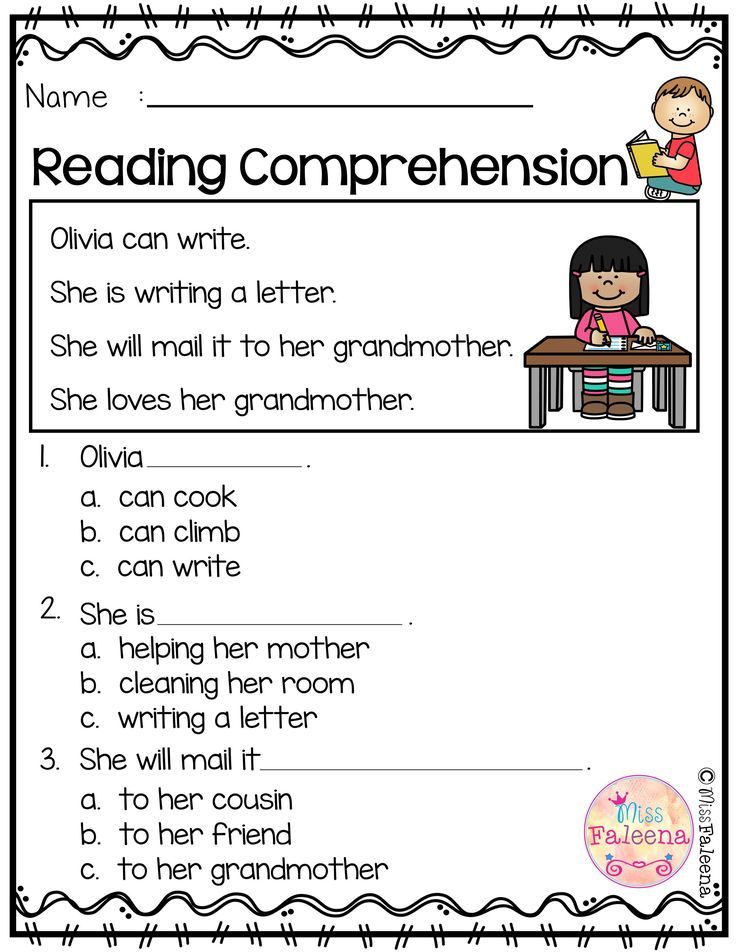 Before you put the stop on a book, before challenging a child who wants to read it, research the book and the author. Don’t judge a book by its cover…or its reputation. Some of the greatest novels have been challenged, banned and burned.
Before you put the stop on a book, before challenging a child who wants to read it, research the book and the author. Don’t judge a book by its cover…or its reputation. Some of the greatest novels have been challenged, banned and burned.
There are so many ways to help your child become a better reader. Many of these tips focus on out-of-the-box ways to encourage kids to pick up a book or to view reading and books positively.
By making reading a fun activity, kids may be more open to guidance to improve comprehension. When parents are concerned that their child struggles with comprehension, opening a dialogue with the teacher may be the first (and best) step to address their struggles.
Intervention, additional testing or perhaps even a medical referral to a specialist could also be needed to pinpoint the cause of a reading struggle. Sometimes, though, kids may simply fall behind and additional help at home may be all that is needed to help boost their proficiency.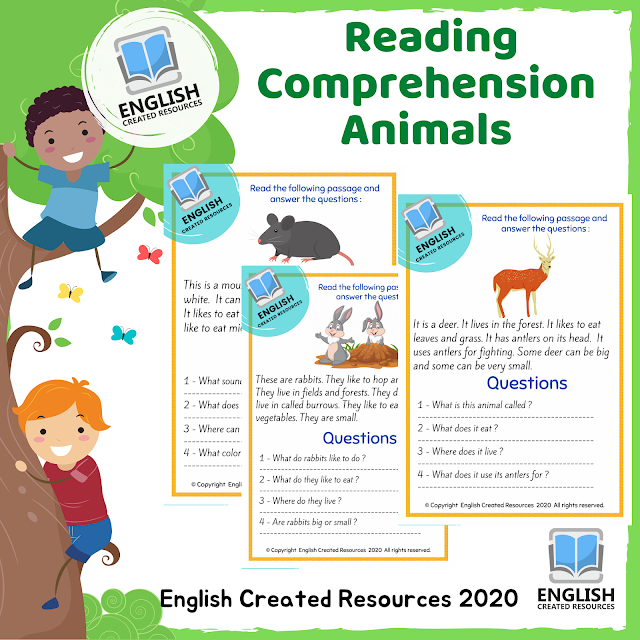
How to teach a child to understand what they read
5481
“Your child reads quickly, but does not understand and cannot retell what exactly he has read” - such phrases are not uncommon at elementary school meetings. Parents are surprised: “The child is reading, how can he not understand what he read?”
Reading is not just a mechanical transformation of letters into words, but also a way of receiving and processing information, its further retelling.
It is important to recognize as early as possible that the child does not understand what they read, while the volume of texts and tasks is not large. This is easy to do by asking questions about the text, for example, about a read fairy tale. Without answers to questions, the child himself may not pay attention to the fact that he does not understand the meaning of what he has read.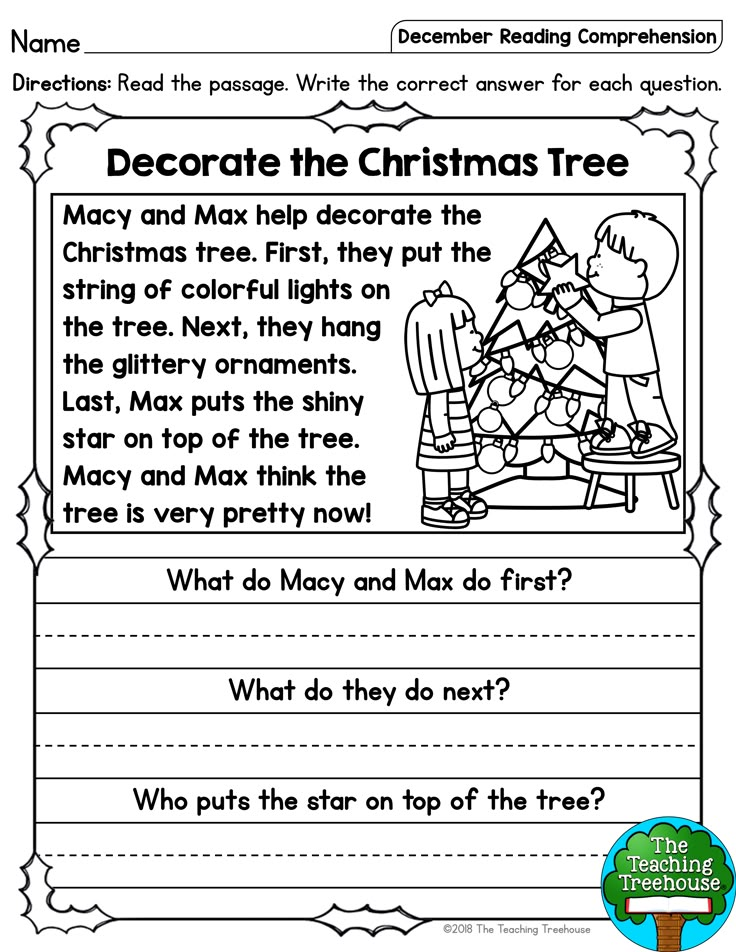
1. Load and fatigue. Modern schoolchildren live in a world of colossal workloads, a high pace of learning. Often, a child reads a phrase and distorts its meaning, because he wants to complete the task as quickly as possible in order to move on to the next one. The child tries to meet the expectations of an adult, he experiences tremendous stress, which leads to chronic fatigue and poor academic performance
2. Automatic reading - the child chatters the text without delving into its meaning. Unfortunately, very often adults primarily pay attention to the speed of reading, and not to its quality. While the child is learning to read, do not chase speed - it is better to read more slowly, but thoughtfully.
3. Small vocabulary. A child can read a word, but not know its meaning and lose the meaning of the entire sentence or even text. Explain to the child that he can ask adults for incomprehensible or unfamiliar words.
There are other factors that affect reading comprehension, but these are the main ones.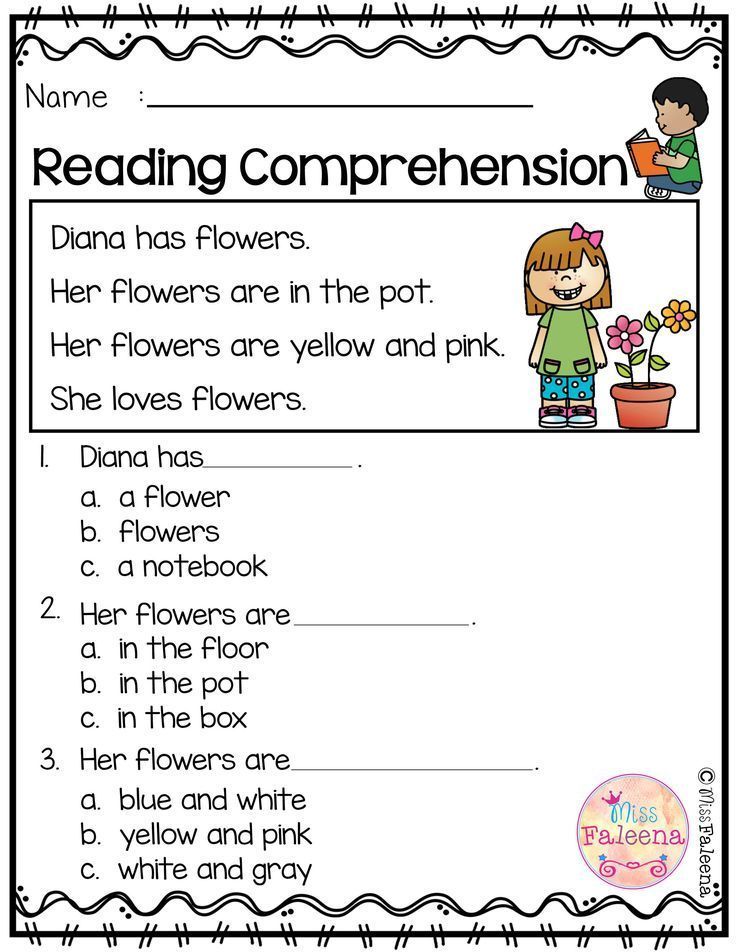
Games for the development of meaningful reading:
1. Puzzles of words, phrases and sentences. An adult writes a word on paper and cuts it into pieces, inviting the child to put together a “puzzle”, over time, the task becomes more complicated to sentences.
2. The word is lost: the adult reads the text and skips the words, the task of the child is to guess which words were “lost”.
3. Vocabulary expansion games: we invite the child to list as many words as possible for a hidden letter. This game is great because you can play it on the way to kindergarten or school or anywhere, because. it does not require any materials and preparation.
4. Children's Scrabble: word building game for children, expands the child's vocabulary
5. Scrabble: from simple words to complex ones. Playing with an adult, the child not only expands vocabulary, but also improves spelling.
6. Theater based on a fairy tale read: an adult will need props, you can use ordinary toys or buy a ready-made puppet set for a certain fairy tale.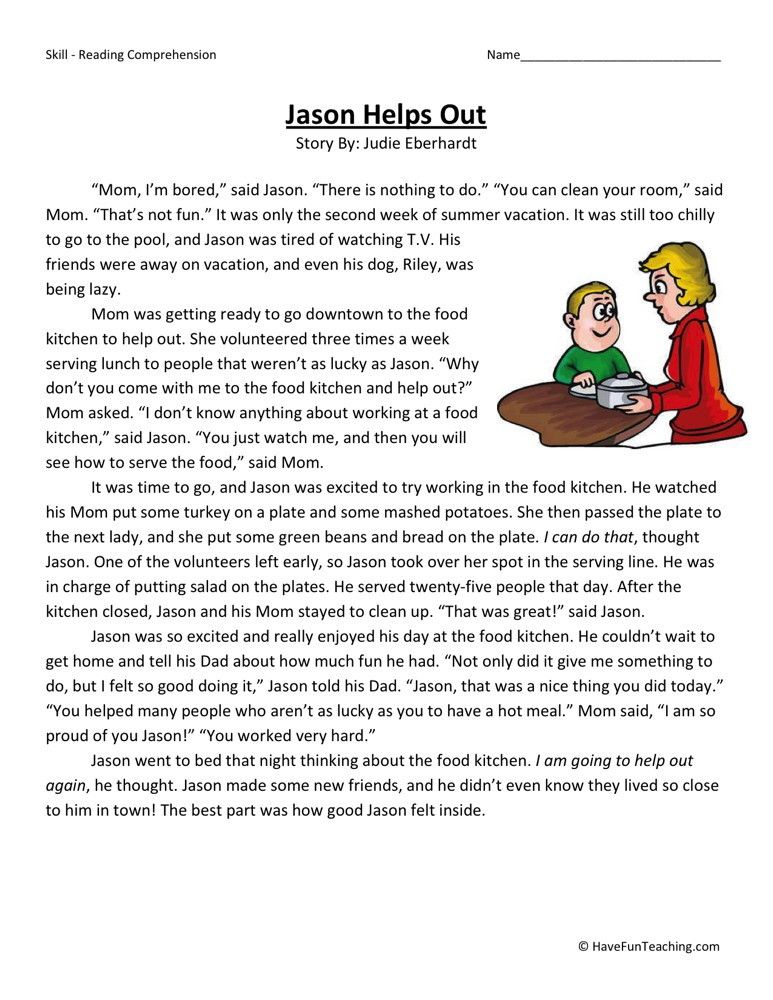 The task of the child is to read the fairy tale and try to reproduce it together with the adult with the help of dolls.
The task of the child is to read the fairy tale and try to reproduce it together with the adult with the help of dolls.
What to do if the child does not understand what they read?
To begin with, the parent must clearly understand that the child is having a hard time, he does not create problems on purpose, he needs help, and adult dissatisfaction will only worsen the situation.
1. Make sure your child knows all the letters of the alphabet with confidence. Not according to the alphabet or cubes, but according to the text, where there are no pictures that can tell.
2. Do not push the child, no matter how slowly he reads. On the contrary, you can stop the child and ask him clarifying questions, especially about words and phrases that caused difficulty reading.
3. After reading the text, be sure to discuss what you read, ask questions to make sure that the child understands what he read.
4. When memorizing verses, also check whether the child understands their meaning. Explain unfamiliar words if necessary.
Explain unfamiliar words if necessary.
5. Let the child read as they like: underlining the line of text with a ruler, sheet or finger. The problem that parents do not attach importance to: the line. A child can simply get lost and confused in the abundance of text, so it is important to underline the readable line.
6. Offer your child books with large text, short phrases, and an interesting plot.
7. A child who does not understand what they read is vulnerable at school in the classroom. Review the task for the next day, sort out what will be incomprehensible - so the child will feel more confident.
8. Be sure to support the child, pay attention to even the smallest of his successes.
In any business, the main thing is practice. Perhaps success will not come immediately, but over time, with regular classes, the child will begin to understand the meaning of what he read.
On the Razumeikin website you will find lessons of different difficulty levels for developing reading skills and reading comprehension. The Learning to Read course will help your child learn to read and understand what they read. Assignments from the section "Reading" in the courses Learning for every age will help in a playful way to learn to understand the meaning of what is read.
The Learning to Read course will help your child learn to read and understand what they read. Assignments from the section "Reading" in the courses Learning for every age will help in a playful way to learn to understand the meaning of what is read.
Did you like it? Share with friends:
Online classes on the Razumeikin website:
-
develop attention, memory, thinking, speech - namely, this is the basis for successful schooling;
-
help to learn letters and numbers, learn to read, count, solve examples and problems, get acquainted with the basics of the world around;
-
provide quality preparation of the child for school;
-
allow primary school students to master and consolidate the most important and complex topics of the school curriculum;
-
broaden the horizons of children and in an accessible form introduce them to the basics of various sciences (biology, geography, physics, chemistry).

We teach the child to understand the meaning of the text. Free Exercises
Many children find it very difficult to make the transition from rote reading to conscious reading. One reason for this may be dyslexia, which makes it difficult for a child to focus on letters and link them into words. Therefore, reading for such children turns into torture. Read more about what this violation is and how to understand if your child has it, read here.
⠀
Another reason why it is difficult for a child to understand what they read is the speed of reading. A child who reads slowly usually forgets what he was reading when he reaches the end of a page or paragraph.
⠀
There can be several reasons for slow reading:
- poor concentration of attention;
- narrow field of vision, when it is difficult for a child to focus on a whole word, phrase or sentence;
- speaking the text aloud or to oneself;
- when reading, the eyes move in a chaotic manner.
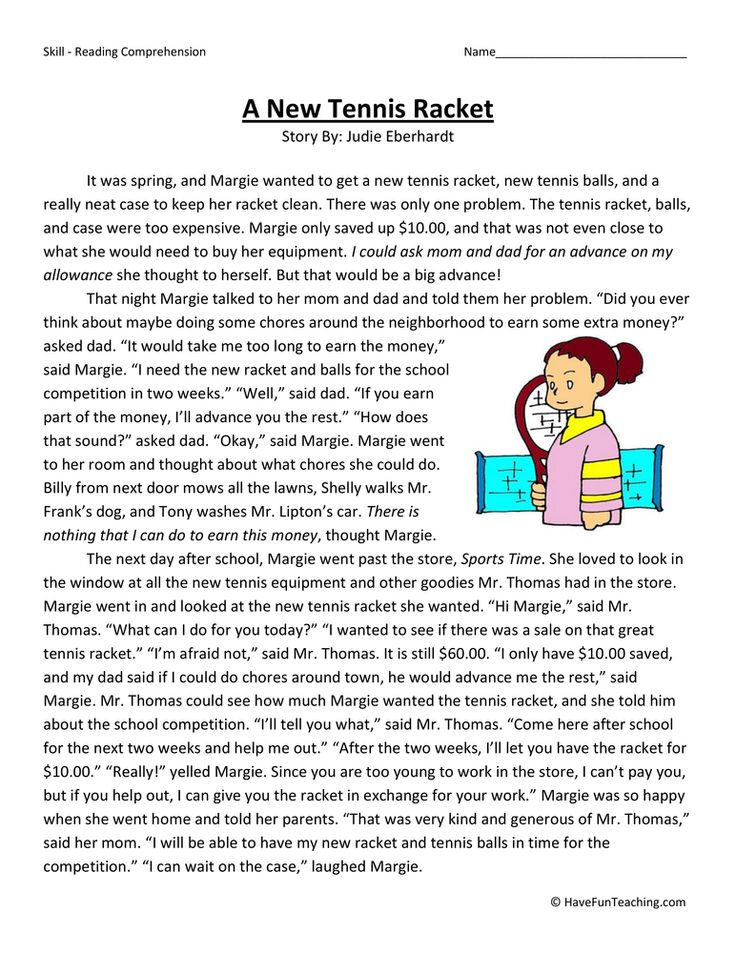
⠀
We will look at a few simple exercises for preschoolers and schoolchildren that will help increase their reading speed.
Learning to read faster
1. Attention exercises
Set a timer and ask the child to name all the letters in alphabetical order starting with the letter A and going down the table.
This exercise also focuses on concentration. Ask the child not to read the words, but in order to name the colors in which the words are written.
2. Getting rid of regression
In order for the child to read word by word, not to jump his eyes from one line to another and to be as focused as possible while reading - give the following exercise 5 minutes a day and the result will not keep you waiting.
Letters, figures, numbers and words that are in the squares must be named sequentially. Through this exercise, the child learns to move his eyes correctly and avoid regression.
⠀
The sooner you get it, the better.
3. At the same time we train concentration of attention and logic
Ask the child to correctly form words in sentences.
Study with your child for 15-20 minutes every day and after 2-3 weeks he will read faster. And if you have already tried, but nothing worked out for you or you simply do not have enough time to study, we offer you our Reading Simulator course.
⠀
After training, your child will learn to read faster, will understand what they read and begin to read with interest, and will be able to write simple sentences in block letters. You can sign up for a trial lesson here.
⠀
Now let's move on to exercises aimed at conscious reading.
7 game exercises that will teach a child to understand what they read
For example, let's take an excerpt from a fairy tale and show all the exercises on it. You can also choose different passages from your child's favorite fairy tales for each exercise.
⠀
In order not to spoil the books and not to type the text, find the electronic version of the fairy tale, select any passage and print it out.
⠀
The text on which we will demonstrate our exercises will be taken from a children's book recommended by our student's mother Elena.
⠀
An excerpt from the book "Shmyak the Kitten" by Robin Scotton
1. Visualizing the text
Pictures help to involve both hemispheres of the child's brain, making it easier for him to understand and remember the meaning of what he read. You can visualize the text using self-made mnemonic tables. Below is an example, and how to do them correctly, read here.
2. Making the text out of parts
Take the printed text and ask the child to read it once or twice. Then cut the text into paragraphs, shuffle it, and ask him to reconstruct the text by putting the pieces together in sequence.
3. Playing teacher
Take the printed text and invite the child to cross out the words from it in such a way that the main meaning is not lost.
4. We train logic and learn to analyze what we read
We invite you and your child to solve word logic problems. Remember the famous Soviet riddle “A, I, B were sitting on a pipe. A - fell, B - disappeared. Who stayed on the pipe? Answer - And remained on the pipe.
Remember the famous Soviet riddle “A, I, B were sitting on a pipe. A - fell, B - disappeared. Who stayed on the pipe? Answer - And remained on the pipe.
⠀
This is a very simple and interesting riddle for preschoolers, which demonstrates to children the great possibilities of the Russian language.
⠀
Below are more examples of tasks for training.
We also recommend that you develop your child's logical thinking by using our simple ideas for creating games from objects that you have at home.
5. Analyzing the text with questions
A good way to help your child build a meaningful chain is to ask questions about the text:
⠀
- Who is the main character?
- What is happening to him?
- Why do you think this is happening to him? Why was he in this situation?
- What does this situation teach him?
- What would you do in this situation?
- Let's imagine what could have happened if he had acted differently?
⠀
Such questions will help the child to grasp the meaning, highlight the main idea and easily retell what they have read.

